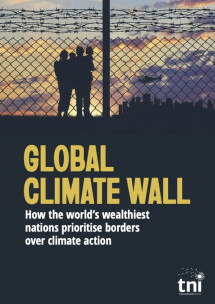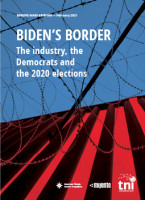Global Climate Wall How the world’s wealthiest nations prioritise borders over climate action
Regions
This report finds that the world’s biggest emitters of green house gases are spending, on average, 2.3 times as much on arming their borders as they are on climate finance. This figure is as high as 15 times as much for the worst offenders. This “Global Climate Wall” aims to seal off powerful countries from migrants, rather than addressing the causes of displacement.

Downloads
-
Global Climate Wall: How the world’s wealthiest nations prioritise borders over climate action (PDF, 2.64 MB)Average time to read: 60 minutes minutes
-
Executive summary: Global Climate Wall (PDF, 1.51 MB)Average time to read: 5 minutes minutes
Authors
Executive summary
The world’s wealthiest countries have chosen how they approach global climate action – by militarising their borders. As this report clearly shows, these countries – which are historically the most responsible for the climate crisis – spend more on arming their borders to keep migrants out than on tackling the crisis that forces people from their homes in the first place.
This is a global trend, but seven countries in particular – responsible for 48% of the world’s historic greenhouse gas (GHG) emissions – collectively spent at least twice as much on border and immigration enforcement (more than $33.1 billion) as on climate finance ($14.4 billion) between 2013 and 2018.
These countries have built a ‘Climate Wall’ to keep out the consequences of climate change, in which the bricks come from two distinct but related dynamics: first, a failure to provide the promised climate finance that could help countries mitigate and adapt to climate change; and second, a militarised response to migration that expands border and surveillance infrastructure. This provides booming profits for a border security industry but untold suffering for refugees and migrants who make increasingly dangerous – and frequently deadly – journeys to seek safety in a climate-changed world.
Key findings:
Climate-induced migration is now a reality
- Climate change is increasingly a factor behind displacement and migration. This may be because of a particular catastrophic event, such as a hurricane or a flash flood, but also when the cumulative impacts of drought or sea-level rise, for example, gradually make an area uninhabitable and force entire communities to relocate.
- The majority of people who become displaced, whether climate-induced or not, remain in their own country, but a number will cross international borders and this is likely to increase as climate-change impacts on entire regions and ecosystems.
- Climate-induced migration takes place disproportionately in low-income countries and intersects with and accelerates with many other causes for displacement. It is shaped by the systemic injustice that creates the situations of vulnerability, violence, precarity and weak social structures that force people to leave their homes.
Rich countries spend more on militarising their borders than on providing climate finance to enable the poorest countries to help migrants
- Seven of the biggest emitters of GHGs – the United States, Germany, Japan, the United Kingdom, Canada, France and Australia – collectively spent at least twice as much on border and immigration enforcement (more than $33.1 billion) as on climate finance ($14.4 billion) between 2013 and 2018.1
- Canada spent 15 times more ($1.5 billion compared to around $100 million); Australia 13 times more ($2.7 billion compared to $200 million); the US almost 11 times more ($19.6 billion compared to $1.8 billion); and the UK nearly two times more ($2.7 billion compared to $1.4 billion).
- Border spending by the seven biggest GHG emitters rose by 29% between 2013 and 2018. In the US, spending on border and immigration enforcement tripled between 2003 and 2021. In Europe, the budget for the European Union (EU) border agency, Frontex, has increased by a whopping 2763% since its founding in 2006 up to 2021.
- This militarisation of borders is partly rooted in national climate security strategies that since the early 2000s have overwhelmingly painted migrants as ‘threats’ rather than victims of injustice. The border security industry has helped promote this process through well-oiled political lobbying, leading to ever more contracts for the border industry and increasingly hostile environments for refugees and migrants.
- Climate finance could help mitigate the impacts of climate change and help countries adapt to this reality, including supporting people who need to relocate or to migrate abroad. Yet the richest countries have failed even to keep their pledges of meagre $100 billion a year in climate finance. The latest figures from the Organisation for Economic Co-operation and Development (OECD) reported $79.6 billion in total climate finance in 2019, but according to research published by Oxfam International, once over-reporting, and loans rather than grants are taken into account, the true volume of climate finance may be less than half of what is reported by developed countries.
- Countries with the highest historic emissions are fortifying their borders, while those with lowest are the hardest hit by population displacement. Somalia, for example, is responsible for 0.00027% of total emissions since 1850 but had more than one million people (6% of the population) displaced by a climate-related disaster in 2020.

The border security industry is profiteering from climate change
- The border security industry is already profiting from the increased spending on border and immigration enforcement and expects even more profits from anticipated instability due to climate change. A 2019 forecast by ResearchAndMarkets.com predicted that the Global Homeland Security and Public Safety Market would grow from $431 billion in 2018 to $606 billion in 2024, and a 5.8% annual growth rate. According to the report, one factor driving this is ‘climate warming-related natural disasters growth’.
- Top border contractors boast of the potential to increase their revenue from climate change. Raytheon says ‘demand for its military products and services as security concerns may arise as results of droughts, floods, and storm events occur as a result of climate change’. Cobham, a British company that markets surveillance systems and is one of the main contractors for Australia’s border security, says that ‘changes to countries [sic] resources and habitability could increase the need for border surveillance due to population migration’.
- As TNI has detailed in many other reports in its Border Wars series,2 the border security industry lobbies and advocates for border militarisation and profits from its expansion.
The border security industry also provides security to the oil industry that is one of main contributors to the climate crisis and even sit on each other’s executive boards
- The world’s 10 largest fossil fuel firms also contract the services of the same firms that dominate border security contracts. Chevron (ranked the world’s number 2) contracts with Cobham, G4S, Indra, Leonardo, Thales; Exxon Mobil (ranking 4) with Airbus, Damen, General Dynamics, L3Harris, Leonardo, Lockheed Martin; BP (6) with Airbus, G4S, Indra, Lockheed Martin, Palantir, Thales; and Royal Dutch Shell (7) with Airbus, Boeing, Damen, Leonardo, Lockheed Martin, Thales, G4S.
- Exxon Mobil, for example, contracted L3Harris (one of the top 14 US border contractors) to provide ‘maritime domain awareness’ of its drilling in the Niger delta in Nigeria, a region which has suffered tremendous population displacement due to environmental contamination. BP has contracted with Palantir, a company that controversially provides surveillance software to agencies like the US Immigration and Customs Enforcement (ICE), to develop a ‘repository of all operated wells historical and real time drilling data’. Border contractor G4S has a relatively long history of protecting oil pipelines, including the Dakota Access pipeline in the US.
- The synergy between fossil fuel companies and top border security contractors is also seen by the fact that executives from each sector sit on each other’s boards. At Chevron, for example, the former CEO and Chairman of Northrop Grumman, Ronald D. Sugar and Lockheed Martin’s former CEO Marilyn Hewson are on its board. The Italian oil and gas company ENI has Nathalie Tocci on its board, previously a Special Advisor to EU High Representative Mogherini from 2015 to 2019, who helped draft the EU Global Strategy that led to expanding the externalisation of EU borders to third countries.
This nexus of power, wealth and collusion between fossil fuel firms and the border security industry shows how climate inaction and militarised responses to its consequences increasingly work hand in hand. Both industries profit as ever more resources are diverted towards dealing with the consequences of climate change rather than tackling its root causes. This comes at a terrible human cost. It can be seen in the rising death toll of refugees, deplorable conditions in many refugee camps and detention centres, violent pushbacks from European countries, particularly those bordering the Mediterranean, and from the US, in countless cases of unnecessary suffering and brutality. The International Organization for Migration (IOM) calculates that 41,000 migrants died between 2014 and 2020, although this is widely accepted to be a significant underestimate given that many lives are lost at sea and in remote deserts as migrants and refugees take increasingly dangerous routes to safety.
The prioritisation of militarised borders over climate finance ultimately threatens to worsen the climate crisis for humanity. Without sufficient investment to help countries mitigate and adapt to climate change, the crisis will wreak even more human devastation and uproot more lives. But, as this report concludes, government spending is a political choice, meaning that different choices are possible. Investing in climate mitigation in the poorest and most vulnerable countries can support a transition to clean energy – and, alongside deep emission cuts by the biggest polluting nations – give the world a chance to keep temperatures below 1.5°C increase since 1850, or pre-industrial levels. Supporting people forced to leave their homes with the resources and infrastructure to rebuild their lives in new locations can help them adapt to climate change and to live in dignity. Migration, if adequately supported, can be an important means of climate adaptation.
Treating migration positively requires a change of direction and greatly increased climate finance, good public policy and international cooperation, but most importantly it is the only morally just path to support those suffering a crisis they played no part in creating.







